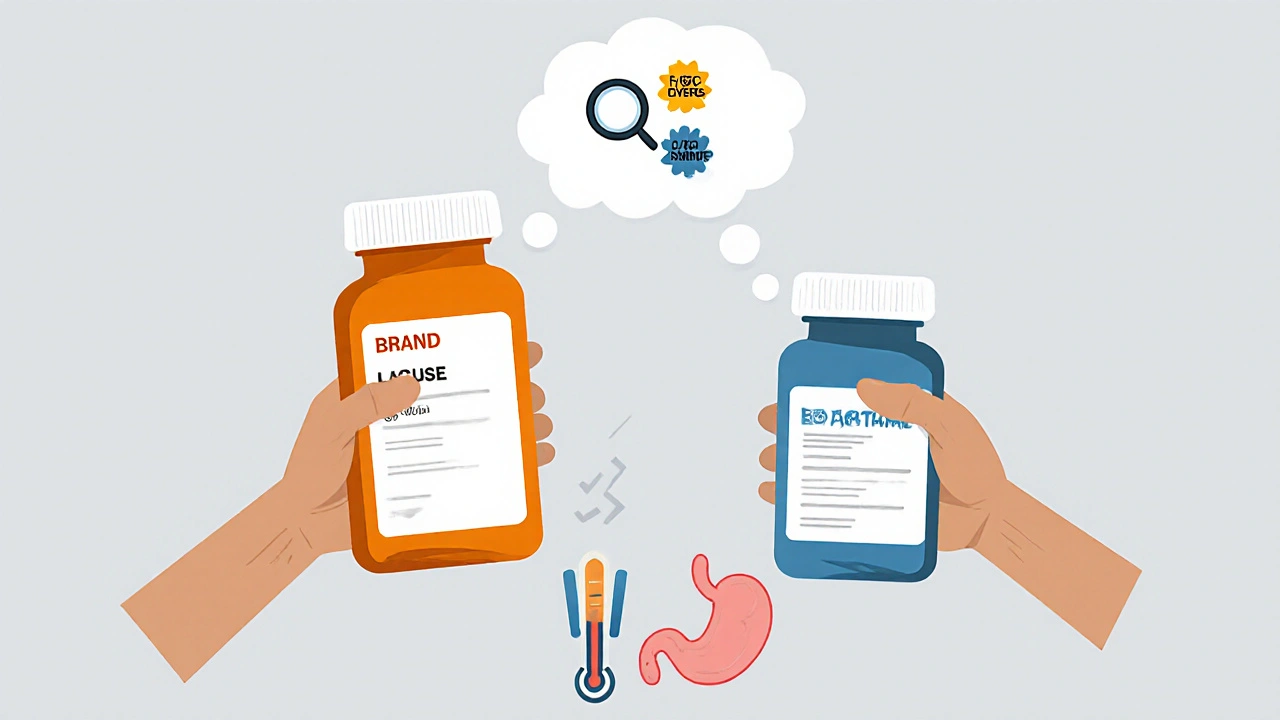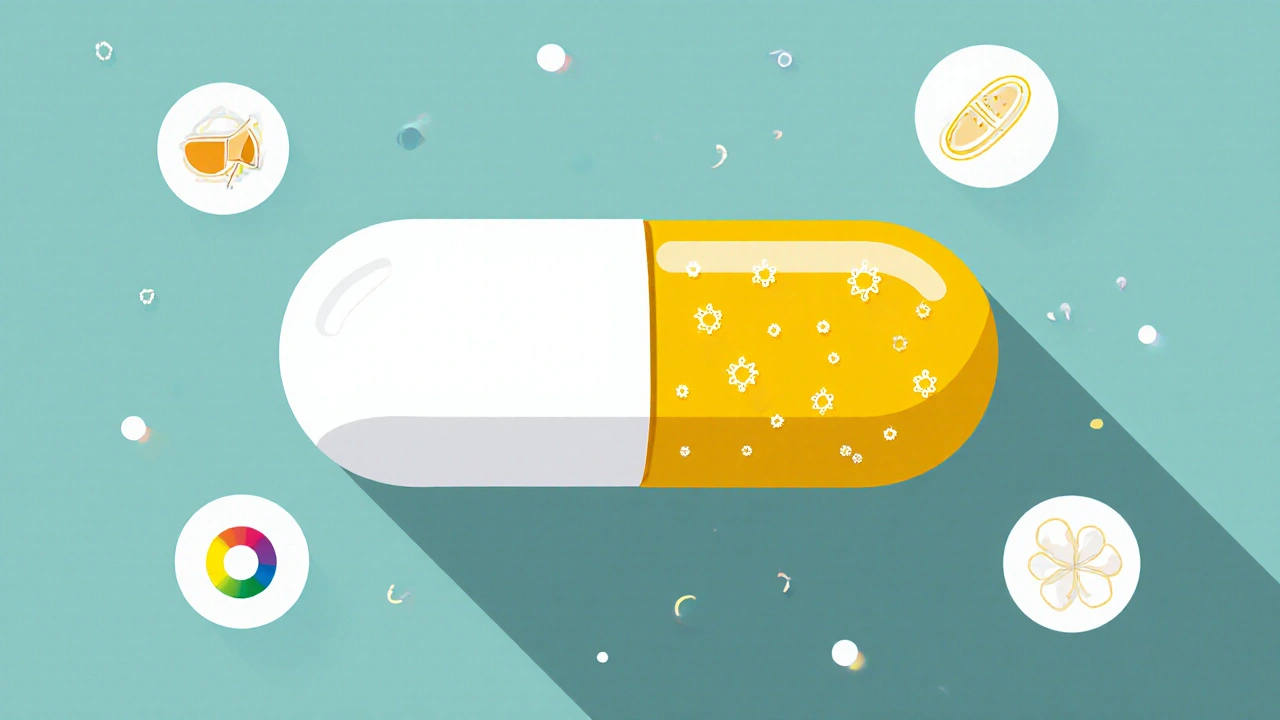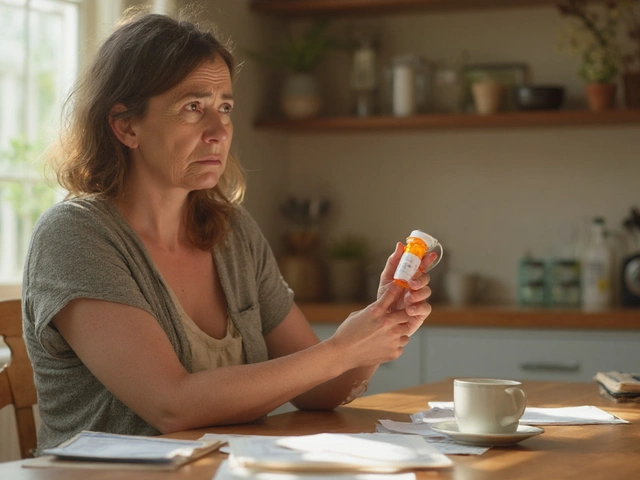Switching from a brand-name drug to a generic version saves money-sometimes hundreds of dollars a month. But if you’ve ever felt off after the switch, you’re not imagining it. The active ingredient is the same. So why do some people feel different? The answer lies in what’s not supposed to matter: the inactive ingredients.
What Are Inactive Ingredients, Anyway?
Inactive ingredients, also called excipients, are the non-medicinal parts of a pill or capsule. They don’t treat your condition. But they do a lot of other jobs. They help the pill hold its shape. They make it easier to swallow. They control how fast the medicine breaks down in your body. Without them, most pills would crumble, taste awful, or not work right.Common examples include:
- Lactose (a milk sugar) - used as a filler in about 40% of oral meds
- Microcrystalline cellulose - a plant-based binder
- Croscarmellose sodium - helps the tablet dissolve
- Hydroxypropyl methylcellulose - a coating for timed release
- Sodium benzoate - a preservative
- FD&C dyes - for color
- Aspartame - in chewable tablets
These ingredients are approved by the FDA as safe for most people. But "safe for most" doesn’t mean safe for everyone.
Why Do Generics Look Different?
You’ve probably noticed that your generic pill looks nothing like the brand-name one. It’s a different color, shape, or size. That’s not an accident. Trademark laws require generics to look different so they can’t be confused with the original. But that means the manufacturer has to use different inactive ingredients to achieve that new look and texture.For example, the brand-name version of your blood pressure pill might use a white, sugar-based coating. The generic might use a yellow, starch-based one. The active ingredient? Identical. But your body might react differently to the new coating-especially if you’re sensitive to starch or dyes.
How Big Is the Real Difference?
The FDA says generics must deliver the same amount of medicine into your bloodstream as the brand version. The standard is strict: the absorption rate must be within 80-125% of the original. That sounds loose, but in practice, most generics are within 4% of the brand. So why do some people feel worse?The answer isn’t in the active ingredient. It’s in how the inactive ingredients affect absorption, stomach irritation, or immune response.
Take levothyroxine, the thyroid hormone replacement. Even tiny changes in fillers can alter how much hormone your body absorbs. A 2023 study found that 8% of patients switching to a new generic version saw their TSH levels shift enough to require a dose adjustment. That’s not a failure of the generic-it’s a sensitivity to the new formulation.
Same goes for antidepressants like sertraline. Patients on Reddit and PatientsLikeMe report more nausea, dizziness, or sleep issues after switching. Many trace it back to a new binder or dye. One user wrote: "I was fine on the brand. The generic made me feel like I had the flu for two weeks. Switched back. Instant relief."

Who’s Most at Risk?
Not everyone will notice a difference. In fact, 95% of people switch without any problem. But certain groups are more likely to react:- People with lactose intolerance: About 36% of Americans can’t digest lactose well. If your generic uses lactose as a filler, you might get bloating, gas, or diarrhea-even if you’ve never had issues with the brand version.
- People with dye allergies: Red 40, Blue 1, and other food dyes are sometimes used in pills. Reactions can include rashes, headaches, or worsening of asthma.
- People with sulfite sensitivity: Around 5% of asthma patients react to sulfites, which appear in some liquid or injectable generics.
- People on narrow therapeutic index drugs: These are meds where the difference between a helpful dose and a dangerous one is small. Examples include warfarin (blood thinner), digoxin (heart medication), and lithium (for bipolar disorder). Even small changes in how the drug is absorbed can cause problems.
- People with celiac disease or gluten sensitivity: While most generics are gluten-free, some use wheat starch as a binder. Always check.
A 2022 Consumer Reports survey found that among people who noticed side effects after switching, 12% blamed lactose, 8% blamed dyes, and 5% blamed sulfites. That’s not a huge number-but if you’re one of them, it’s everything.
What You Can Do
You don’t have to accept feeling worse. Here’s how to take control:- Check the ingredient list. Every prescription bottle lists inactive ingredients. Look for them on the label or ask your pharmacist for the full list. Don’t assume it’s the same as before.
- Compare old and new. Keep a copy of the old pill’s ingredient list. When you get a new generic, compare them side by side. If a new filler like lactose or aspartame shows up, that’s your clue.
- Track your symptoms. Keep a simple log for 2-4 weeks after switching. Note mood, sleep, digestion, energy, and any new side effects. This helps your doctor spot patterns.
- Ask for an "authorized generic". These are made by the original brand company but sold under a generic label. They have the exact same inactive ingredients. They’re not always cheaper than regular generics, but they’re the closest you’ll get to the brand.
- Ask your pharmacist to check for allergen-free options. Some pharmacies now stock generics without common allergens. It’s becoming more common.

Is It Worth the Risk?
Yes-for most people. Generics save the U.S. healthcare system over $2 trillion a decade. They’re just as safe and effective for 95% of users. The cost difference is massive: Lipitor (brand) costs around $370 a month. The generic? About $4.But if you’re in the 1-2% who notice a difference, that 1% matters. You’re not being difficult. You’re not imagining it. Your body is reacting to something real.
Don’t feel pressured to stick with a generic if it’s making you feel worse. Talk to your doctor. Ask for a different generic version. Or go back to the brand if your insurance allows it. Your health isn’t a cost center.
What’s Changing?
The FDA is paying more attention. In 2023, they released new draft guidance requiring stricter testing for generics of high-risk drugs like levothyroxine and warfarin. They’re also expanding their Inactive Ingredient Database, which will let you look up every excipient approved for use in any medication-down to the maximum allowed amount.Pharmaceutical companies are starting to respond. More "clean label" generics are hitting the market-fewer dyes, no lactose, no artificial sweeteners. By 2025, experts predict 70% of generic manufacturers will offer allergen-free versions of common meds.
This isn’t about rejecting generics. It’s about making them better for everyone-even the people who react to the little things.
Can inactive ingredients in generics cause real side effects?
Yes. While the active ingredient is the same, inactive ingredients like lactose, dyes, or preservatives can cause gastrointestinal upset, headaches, rashes, or worsened asthma in sensitive individuals. About 1-2% of patients report noticeable side effects after switching to a generic, often linked to these fillers.
Are generics less effective than brand-name drugs?
No. Generics must meet the same FDA standards for strength, purity, and effectiveness as brand-name drugs. Bioequivalence testing ensures they deliver the same amount of medicine into your bloodstream. For 95% of people, there’s no difference in how well they work.
Why does my generic pill look different?
Trademark laws require generic drugs to look different from the brand version. That means different colors, shapes, or sizes-often achieved by changing inactive ingredients like dyes or coatings. The active ingredient remains identical.
What should I do if I feel worse on a generic?
Don’t ignore it. Track your symptoms for 2-4 weeks, then talk to your doctor or pharmacist. Ask to compare the inactive ingredients of your old and new pills. You may need to switch to a different generic version, request an authorized generic, or return to the brand if necessary.
Are there generics without lactose or dyes?
Yes. More manufacturers are offering "allergen-free" or "clean label" generics without common irritants like lactose, artificial dyes, or aspartame. Ask your pharmacist if they carry versions without these ingredients-especially if you have sensitivities.
Can I trust the FDA’s approval of generics?
Yes. The FDA requires rigorous testing for safety and effectiveness. But approval doesn’t mean every person will react the same way. The agency acknowledges that minor differences in inactive ingredients can affect sensitive individuals. Their focus is on population-level safety-not individual biochemistry.
What’s an "authorized generic"?
An authorized generic is made by the original brand-name manufacturer but sold under a generic label. It has the exact same active and inactive ingredients as the brand. It’s often cheaper than the brand but sometimes more expensive than regular generics. It’s the safest switch if you’ve had problems before.



 Medications
Medications





Holly Schumacher
November 24, 2025 AT 02:25I’ve been on levothyroxine for 12 years, and I swear-every time I get a new generic, I feel like I’ve been hit by a truck for two weeks. Fatigue, brain fog, heart palpitations. I tracked it. Same active ingredient. Different filler. This time it was lactose. I have no idea why pharmacies keep switching me. I’m not ‘overreacting.’ My TSH went from 1.8 to 4.7. That’s not ‘within range.’ That’s a medical emergency waiting to happen. And no, I won’t take ‘it’s fine for most people’ as an answer. My body isn’t a statistic.
I now only take the authorized generic. It costs more, but my life isn’t a cost-benefit analysis for Big Pharma.
Michael Fitzpatrick
November 24, 2025 AT 08:55You know, I used to think this was all in people’s heads too-until my mom switched to a generic version of her blood pressure med and started having dizzy spells every afternoon. She didn’t even connect it until she noticed the pill looked different. Turns out, the new one had FD&C Red 40 in it, and she’s had a mild sensitivity to dyes since childhood. She didn’t even know that was possible. I think the real issue isn’t the science-it’s that we assume everyone’s body reacts the same way to the same chemical. But we’re all a little different. And that’s okay. Maybe we just need to start listening more and assuming less.
Also, props to the article for actually explaining the ‘why’ instead of just saying ‘it’s fine.’
Shawn Daughhetee
November 25, 2025 AT 08:30my doctor just shrugged when i told him i felt weird after switching to the generic version of my antidepressant
he said 'it's the same drug' like that's the end of the conversation
but i felt like i had the flu for 10 days straight
switched back to brand and boom-normal again
now i just ask for the authorized generic every time
pharmacist knows me by name
and honestly? worth every extra dollar
mental health isn't a bargaining chip
Melvina Zelee
November 25, 2025 AT 23:00people keep saying '95% are fine' but what about the 5% who arent
imagine if your car only worked 95% of the time and the other 5% it just stalled in the middle of the highway
youd call that a defect
but when it comes to our bodies? we just say 'oh well try another one'
im tired of being told im being dramatic because my body reacts to things that dont affect others
we need better labeling
and pharmacies need to stop randomly switching us without telling us
im not asking for luxury
i just want to not feel sick while taking medicine meant to make me well
Patrick Marsh
November 27, 2025 AT 17:06Check the label. Compare. Document. Ask for alternatives. Done.
Daniel Jean-Baptiste
November 29, 2025 AT 16:14in canada we dont have the same generic switching chaos
pharmacies usually stick to one version unless you ask for a change
and the labels are way more detailed
they even list if it contains gluten or lactose right on the front
it makes me wonder why the us is so behind
its not hard
just human
New Yorkers
November 30, 2025 AT 23:53you people are pathetic. you’re not ‘sensitive.’ you’re weak. if you can’t handle a pill because it has a little starch or dye, you shouldn’t be taking pills at all. the system works. your body is broken, not the medicine. stop whining and take your damn medication like an adult. this isn’t a support group for people who think their immune system is a snowflake.
David Cunningham
December 1, 2025 AT 03:40just had this happen with my asthma inhaler generic-switched to one with sulfites and nearly ended up in the ER. never knew sulfites were in meds. now i always check the ingredients. even if it's 'approved by the FDA,' that doesn't mean it's safe for YOU. i'm from australia and we have this thing called 'personal responsibility'-and yeah, it includes reading the tiny print on the bottle. don't wait until you're gasping to learn this.
luke young
December 2, 2025 AT 10:43my sister has celiac and she had a bad reaction to a generic version of her anxiety med because it had wheat starch. no one told her. she ended up in the hospital. now she only takes the brand or the authorized generic. it’s expensive but she’s alive. this isn’t about being picky-it’s about being informed. i wish more pharmacists would just say ‘hey, this one has gluten’ instead of making us guess.
james lucas
December 4, 2025 AT 04:19so i switched to a new generic of my cholesterol med and started getting terrible heartburn
thought it was my diet
then i noticed the new pill had aspartame in it
and i’ve had a weird sensitivity to artificial sweeteners since i was a kid
switched back to the old generic-no more burning
so yeah
it’s real
and no one ever tells you
pharmacies just swap them out like they’re trading baseball cards
and you’re supposed to just… deal with it
we need a database
like a google search for ‘what’s in this pill’
not just the active ingredient
but the whole damn list
and it should be on the bottle in big letters
because this isn’t a mystery
it’s negligence
Jessica Correa
December 4, 2025 AT 23:12i have lactose intolerance but never knew it affected my meds until i started getting bloated after switching generics
now i keep a screenshot of every pill i take
and i ask the pharmacist to show me the ingredients before they hand it over
they think i’m annoying
but i’d rather be annoying than in pain
also-why is lactose even in pills
its not like we dont have other fillers
why are we still doing this
its 2025
manish chaturvedi
December 5, 2025 AT 02:32In India, we face a different problem-counterfeit generics with no regulation at all. But I appreciate this article because it highlights that even in highly regulated systems like the U.S., the invisible ingredients can cause real harm. The FDA’s new draft guidance is a step forward. But patients need to be empowered, not just informed. We need a standardized, accessible database-preferably mobile-friendly-where anyone can scan a pill barcode and instantly see all excipients, allergens, and manufacturing origin. This isn’t luxury. This is basic patient safety. We must stop treating bodies as interchangeable parts.
Holly Schumacher
December 6, 2025 AT 21:36And to the guy who said we’re weak-thanks for proving why this system is broken. You don’t understand because your body doesn’t react. That doesn’t mean the rest of us are broken. It means your privilege is blindness. I’ve been told to ‘just take it’ for 12 years. I’ve lost jobs because I was too tired. I’ve cried in pharmacy aisles because no one would listen. I’m not asking for special treatment. I’m asking for basic respect. If your kid had a peanut allergy, you’d check every label. Why is my thyroid any different?